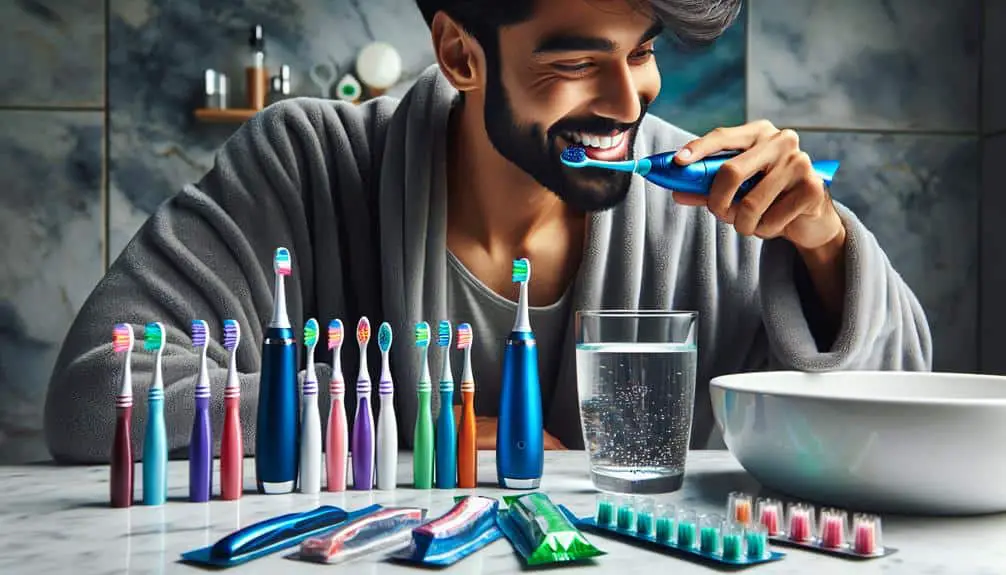To sustain a bright white smile, focus on regular brushing and flossing with a soft-bristled brush and fluoride toothpaste. Brush at a 45-degree angle in gentle circles, including your tongue, and floss gently in a C shape between each tooth. Limit foods and drinks that stain teeth, use whitening toothpaste with hydrogen peroxide or baking soda, schedule professional cleanings, and incorporate touch-ups with whitening products. Consistent care and attention to oral hygiene habits can help you achieve and maintain a radiant smile. Remember, a bright white smile is within reach with these simple yet effective tips.
Key Points
- Practice proper brushing and flossing techniques daily.
- Limit consumption of staining foods and drinks.
- Use whitening toothpaste with gentle brushing.
- Schedule regular professional cleanings.
- Incorporate touch-ups with whitening products as needed.
Regular Brushing and Flossing
To maintain a bright white smile, it's important to consistently brush and floss your teeth at least twice a day. Proper technique is essential for effective plaque removal. When brushing, use a soft-bristled brush and fluoride toothpaste. Hold the brush at a 45-degree angle and use gentle circular motions to clean all tooth surfaces. Remember to brush not just your teeth but also your tongue to eliminate bacteria that can cause bad breath.
Flossing is equally significant as it removes plaque and food particles from between your teeth and under the gumline. Use about 18 inches of floss, winding most of it around your middle fingers, and hold a small section taut between your thumbs and index fingers. Gently slide the floss between each tooth in a C shape and move it up and down to make sure all debris is removed.
Regular dental visits are necessary to maintaining oral health. Dentists can detect early signs of issues and provide professional cleanings to complement your at-home oral care routine. Make sure to schedule check-ups at least twice a year to keep your smile radiant and healthy.
Limit Staining Foods and Drinks
To prevent discoloration of your teeth, be mindful of the foods and drinks that can cause staining. Certain items in your diet can contribute to the yellowing or browning of your teeth, affecting the brightness of your smile.
Here are some tips to help you maintain a radiant white smile through dietary modifications:
- Avoid or Limit: Foods and beverages such as coffee, tea, red wine, and dark sodas can stain your teeth over time. Try to reduce your consumption of these staining culprits.
- Use a Straw: When drinking beverages that can stain your teeth, like coffee or tea, consider using a straw to minimize contact with your teeth.
- Rinse or Brush: After consuming staining foods or drinks, rinse your mouth with water or brush your teeth if possible to help prevent the substances from lingering on your teeth.
- Choose Teeth-Friendly Snacks: Opt for teeth-whitening treatments or snacks like crunchy fruits and vegetables that can naturally help clean your teeth while you eat.
Use Whitening Toothpaste
Consider incorporating whitening toothpaste into your daily oral care routine for a brighter smile. Whitening toothpaste is formulated to help remove surface stains on your teeth, making them appear whiter. The effectiveness of whitening toothpaste can vary depending on the brand and the ingredients it contains. Look for toothpaste that includes whitening ingredients such as hydrogen peroxide or baking soda, as these are known to help lighten tooth color effectively.
Toothpaste effectiveness in whitening can be influenced by how often you brush and the technique you use. It's recommended to brush your teeth at least twice a day for two minutes each time, ensuring you cover all surfaces thoroughly. When using whitening toothpaste, be mindful of not brushing too hard, as this can damage your enamel over time. Additionally, give it some time to work – results may not be immediate, but with consistent use, you should start to see a difference in the brightness of your smile.
Schedule Professional Cleanings
Scheduling regular professional cleanings with your dentist is vital for maintaining a bright and healthy smile. These visits aren't just about cleaning; they play an essential role in preventing dental issues and keeping your teeth looking their best. Here are four reasons why scheduling professional cleanings is key to sustaining a bright white smile:
- Preventive Measures: Professional cleanings help prevent gum disease, cavities, and other oral health issues by removing plaque and tartar buildup that regular brushing and flossing may miss.
- Early Detection: Regular dental check-ups during these cleanings allow your dentist to spot any potential problems early on, saving you from more extensive and costly treatments in the future.
- Customized Care: Your dentist can provide personalized advice on oral hygiene practices, diet, and lifestyle habits tailored to your specific needs to maintain a white smile.
- Professional Tools: The specialized tools used during professional cleanings can reach areas that regular brushing and flossing cannot, ensuring a thorough clean for a brighter smile.
Touch-Ups With Whitening Products
For maintaining your bright white smile between professional cleanings, incorporating touch-ups with whitening products can help enhance and prolong the results. Whitening toothpaste and over-the-counter whitening strips are popular options for touch-ups at home. Whitening toothpaste contains mild abrasives or enzymes that gently polish the teeth and remove surface stains. However, it may not be as effective for deeper stains. On the other hand, whitening strips use hydrogen peroxide or carbamide peroxide to bleach the teeth and are more effective in removing stains.
When using whitening products at home, it's vital to follow the instructions carefully to avoid damaging your teeth or gums. Overusing whitening products can lead to tooth sensitivity and gum irritation. Additionally, incorporating natural methods like oil pulling with coconut oil or using baking soda can help maintain a bright smile.
Remember that while home remedies can be effective to some extent, professional cleanings and consultations with a dentist are essential for long-term oral health and maintaining a bright white smile.
Frequently Asked Questions
Can Genetics Play a Role in the Whiteness of Your Smile?
Genetics can greatly impact the whiteness of your smile. Research shows that approximately 60% of enamel strength is determined by genetics. Understanding this can help tailor your oral care routine for best results.
Is It Safe to Use DIY Whitening Kits at Home?
Using DIY whitening kits at home can be risky. Professional advice is essential for safety precautions and effectiveness. Without guidance, you may experience adverse effects. Consult with a dentist before attempting at-home treatments.
How Often Should I Replace My Toothbrush for Optimal Whitening Results?
For prime whitening results, replace your toothbrush every 3 months. Proper toothbrush maintenance is crucial. Use gentle pressure and circular motions when brushing. Remember, a fresh brush leads to a brighter smile.
Are There Any Natural Remedies That Can Help Whiten Teeth?
To naturally whiten teeth, consider herbal remedies like baking soda or activated charcoal. Oil pulling with coconut or sesame oil can also help remove stains. These methods can be effective, but it is important to use them cautiously.
Can Stress and Anxiety Affect the Brightness of Your Smile?
Stress and anxiety can dim your smile's radiance. Prioritize stress management and relaxation techniques to regain that bright sparkle. Your smile deserves to shine as brilliantly as you feel inside. You've got this!




